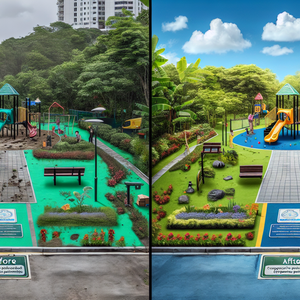Bridging the Gap: Industry Collaboration in STEM Higher Education

As technology continues to evolve at an unprecedented pace, traditional educational models often fall short of preparing graduates for the workforce. This disconnect can lead to a skills gap where employers struggle to find qualified candidates, while graduates feel ill-equipped to meet job demands. A collaborative approach between educational institutions and industry leaders not only addresses this gap but also enriches the educational experience. By ensuring that curricula are aligned with real-world demands, these partnerships equip students with the skills and knowledge necessary to thrive in their careers.
Successful Models of Industry-Academia Partnerships
Internship programs stand out as one of the most effective ways to bridge the gap between education and industry. Institutions like the Massachusetts Institute of Technology (MIT) and Stanford University have formed partnerships with leading tech companies, allowing students to gain valuable hands-on experience while still in school. For instance, MIT's collaboration with companies like Google and IBM provides students with opportunities to work on projects that mirror industry challenges. These internships not only enhance students' skill sets but also allow employers to assess potential hires in a real-world context, fostering mutually beneficial relationships.
Curriculum Co-Development
Co-developing curricula with industry partners is another successful model that ensures educational content reflects current industry practices. Georgia Tech, for example, collaborates with telecommunications giant AT&T to design courses that incorporate the latest technologies and practices. This partnership enables students to learn relevant content directly applicable to their future careers, thereby enhancing their readiness for the workforce. Such curriculum innovations prepare students to tackle real challenges in their field, ensuring they are not only knowledgeable but also practical problem solvers.
Guest Lectures and Workshops
Inviting industry professionals to conduct guest lectures and workshops provides students with unique insights into the practical applications of their studies. For example, the University of California, Berkeley frequently hosts industry experts to share their experiences and insights with students. This exposure not only enriches the educational experience but also helps students understand the evolving landscape of their fields, preparing them for the realities of the job market.
Strategies for Enhancing Collaboration
Creating advisory boards that include industry leaders can significantly enhance collaboration. These boards help educational institutions stay informed about workforce trends and needs, providing valuable feedback on curriculum development. By identifying skills gaps and emerging industry demands, advisory boards can guide institutions in designing programs that better prepare students for careers in STEM.
Creating Innovation Hubs
Innovation hubs or incubators that bring together students, faculty, and industry partners are another effective strategy for enhancing collaboration. The University of Michigan's Innovation Partnership Program exemplifies this approach, where students collaborate with companies to tackle real-world problems. These hubs foster a culture of innovation and creativity, allowing students to develop solutions that benefit both their academic pursuits and industry partners.
Fostering Research Partnerships
Collaborative research projects between universities and industry can lead to groundbreaking advancements while providing students with opportunities to work on cutting-edge technologies. Programs like the National Science Foundation's Industry-University Cooperative Research Centers facilitate such partnerships, encouraging joint research initiatives that benefit both academia and industry. This collaboration not only enhances students' research skills but also positions them at the forefront of innovation.
The collaboration between industry and academia in STEM higher education is not merely a trend; it is an essential requirement for the future of work. By forging strong partnerships, educational institutions can ensure that their curricula meet the evolving needs of the job market, ultimately enhancing student employability and fostering innovation. As we move forward, it is crucial for educators and industry leaders to continue exploring and expanding these collaborations, creating a more integrated educational ecosystem that prepares the next generation for success in an ever-changing world. Bridging the gap between education and industry not only benefits students and employers but also contributes to a more dynamic and innovative economy.
Data Analyst in STEM Education
Educational institutions, government agencies, nonprofit organizations focused on education
Core Responsibilities
Analyze educational data to identify trends and areas for improvement in STEM programs.
Collaborate with academic departments to develop data-driven strategies for curriculum enhancement.
Prepare reports and presentations to communicate findings to stakeholders.
Required Skills
Proficiency in statistical software (e.g., R, Python, SQL) and data visualization tools (e.g., Tableau, Power BI).
Strong analytical and problem-solving skills with an understanding of educational metrics.
Experience with data collection methods and assessment frameworks.
STEM Curriculum Developer
K-12 schools, universities, educational technology companies
Core Responsibilities
Design and develop STEM-related curricula that align with industry standards and future workforce needs.
Collaborate with industry experts to integrate real-world applications into educational content.
Evaluate and revise curriculum materials based on student feedback and industry trends.
Required Skills
Bachelor's or Master’s degree in Education, STEM field, or related discipline.
Strong understanding of instructional design principles and educational technology.
Excellent communication skills for articulating curriculum goals and concepts to diverse audiences.
Industry Partnerships Manager
Universities, community colleges, workforce development organizations
Core Responsibilities
Establish and maintain relationships with industry leaders to create collaborative educational initiatives.
Coordinate internship and cooperative education programs that connect students with industry opportunities.
Organize events and workshops that foster engagement between faculty, students, and industry representatives.
Required Skills
Strong networking and interpersonal skills, with the ability to build rapport with diverse stakeholders.
Project management experience, particularly in educational or corporate settings.
Knowledge of current trends in STEM fields and workforce development.
Educational Technology Specialist
School districts, educational institutions, ed-tech companies
Core Responsibilities
Implement and support technology solutions that enhance STEM education and learning outcomes.
Provide training and resources for educators on integrating technology into their teaching practices.
Assess the effectiveness of educational technologies and recommend improvements based on user feedback.
Required Skills
Experience with learning management systems (LMS) and educational software tools.
Strong technical skills and the ability to troubleshoot technology issues in an educational setting.
Familiarity with instructional design and pedagogical strategies in STEM education.
STEM Outreach Coordinator
Nonprofit organizations, universities, community education programs
Core Responsibilities
Develop and implement programs to engage K-12 students in STEM fields through workshops, camps, and competitions.
Partner with schools and community organizations to promote STEM education initiatives.
Measure program effectiveness and report outcomes to stakeholders and funding bodies.
Required Skills
Strong communication and organizational skills, with experience in event planning and program management.
Knowledge of STEM subjects and effective teaching strategies for diverse audiences.
Ability to work collaboratively with educators, students, and industry professionals.


